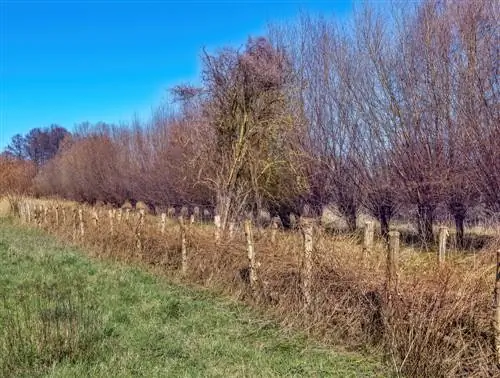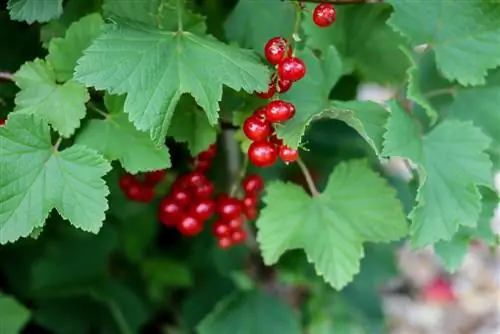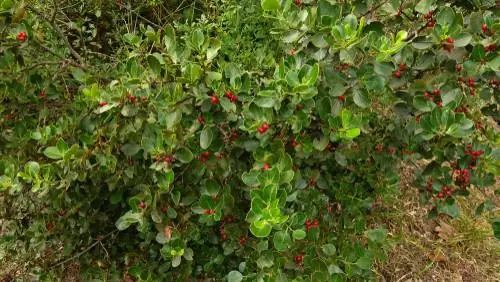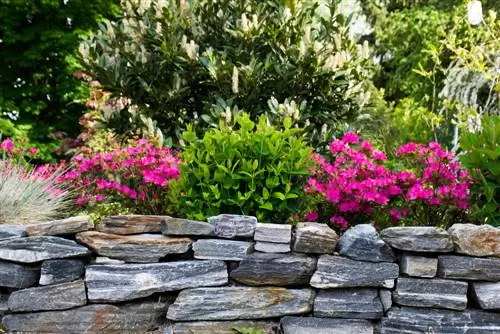- Author admin [email protected].
- Public 2024-01-15 08:07.
- Last modified 2025-06-01 06:02.
As a deadwood hedge, pruning takes on new honor and enriches the garden as an oasis of life. Read a compact definition with information about the concept and benefits in this green guide. You can find out how to properly create and green a deadwood hedge here.

What is a deadwood hedge in the garden?
A deadwood hedge is a loose pile of wood cuttings between rows of posts that serves as a habitat for plants, insects and small animals. It is an ecologically valuable and natural privacy screen in the garden, which consists of local plants and clippings.
- Deadwood hedge is a loose pile of wood cuttings between two rows of posts, which serves as a habitat for plants, insects and small animals.
- Natural hobby gardeners can build a deadwood hedge themselves from thick branches driven into the ground, 60-100 cm apart and 0.5-2 m wide.
- The greening of a deadwood hedge should be accelerated by sowing or planting native flowers, perennials and trees.
What is a deadwood hedge?
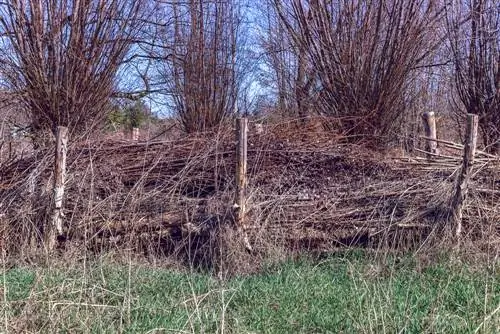
A deadwood hedge contains a lot of life
As a hedge, mundane dead wood is transformed into a source of life. The well-known nature photographer, writer and landscape gardener Hermann Benjes propagated this insight in the early 1980s. In his search for an uncomplicated and sensible way to use wood cuttings, the ecologically valuable concept took concrete form in his writings. The following definition gets to the heart of what lies behind the term deadwood hedge:
Definition: Deadwood hedges are loose, linear layers of predominantly thin wood cuttings in which plants, insects and small animals gradually settle.
Based on the founder and advocate of the ecological principle, the deadwood hedge is also called the Benje hedge. With the slogan “Long live the dead wood,” the German Nature Conservation Association took up the concept and developed it further. NABU promotes the deadwood hedge to all generations of gardeners as one of the most vibrant habitats in our nature.
Concept and benefits
According to the basic principle, a deadwood hedge is created without any new planting. Tree cuttings stacked between simple wooden posts provide a natural basis for incoming seeds. A diverse plant community is created that insects and small mammals value as a source of food. At the same time, the wall takes on important protective functions for the flora and fauna it houses. A lively mini-ecosystem gradually unfolds. At the same time, the hobby gardener always knows where to put the clippings from his trees and benefits from a privacy screen for free.
Tip
The deadwood hedge is on the rise as a natural alternative to expensive fences, massive walls and high-maintenance hedges. From a height of 180 centimeters, a Benje hedge can be used as a self-made privacy screen to ward off prying eyes and maintain privacy in the garden. Caution: As with all fencing, the deadwood hedge may require a separate building permit.
Creating a deadwood hedge - building instructions for beginners
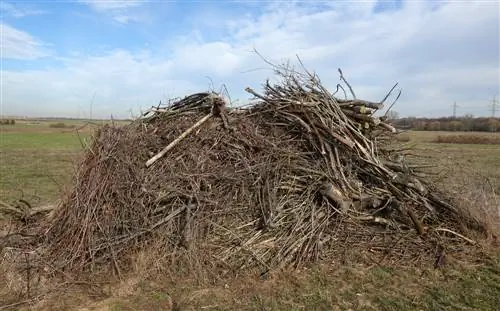
There are different ways to create a deadwood hedge
Have you been captivated by the tried and tested concept of the Benjes hedge with its many advantages? Then integrate the natural oasis of life into your garden using simple means. The following construction instructions explain step by step how to properly create a deadwood hedge:
Material and tools
Hobby gardeners don't have to dig deep into their pockets if they build a deadwood hedge themselves. The following materials are already ready to hand in the garden and toolbox. Green waste disposal facilities, road maintenance departments or gardening companies are happy to hand out suitable wooden posts to those who collect them free of charge:
- thick, straight branches or wooden posts 150-200 cm long (ideally hardwood, such as oak, beech, apple tree, pear tree and similar)
- Marking cord with small pegs
- Folding rule, carpenter's pencil
- Wooden mallet, fence mallet or sledgehammer
- ladder
- Handsaw
Step-by-step instructions
The best time to start building your own Benjeshecke brand is in spring, when pruning care is on the agenda for most trees and shrubs. Please note that the following information on the structure, width and spacing of the posts only serves as a suggestion and leaves plenty of scope for individual solutions. How to build a deadwood hedge correctly:
- Measure the hedge lengthwise
- Mark 2 parallel rows of posts with a stretched cord for a hedge width of 0.5 to 2 m
- Sharpen wooden posts at the bottom
- Mark the impact depth of 30 cm clearly on each post
- Lay posts on each side of the hedge at a distance of 60-100 cm along the cords
- take each post in your hand, climb the ladder and pound it into the ground up to the mark
- Rule of thumb: the shorter the clippings, the shorter the post distance
In the last step, fill the hedge frame with branches and twigs. Ideally, you start with thicker branches and pile thinner twigs and sticks on top of them. Cut off any protruding shoots. You can weave long branches between the posts to optimize the stability of the deadwood hedge.
In the following video you can see how a deadwood hedge is created in gardener Birgit Recktenwald's natural garden.

Greening deadwood hedges - ideas for the planting plan
It takes many years for a lush plant community to settle in a deadwood hedge without your intervention. You can speed up the growth process within the wall by integrating native plants into the structure. The following table may inspire you to plant your Benje hedge creatively and true to the concept:
| Perennials/Flowers | botanical name | Shrubs | botanical name | climbing plants | botanical name |
|---|---|---|---|---|---|
| Aquilegia | Aquilegia vulgaris | Cornelian cherry | Cornus mas | Yellow clematis | Clematis akebioides |
| wood anemones | Anemone nemorosa | Sourthorn | Berberis vulgaris | Knotweed | Polygonum aubertii |
| Bellflower | Campanula latifolia | buddleia | Buddleja davidii | woman's coat | Alchemilla mollis |
| mullein | Verbascum | Blackthorn | Prunus spinosa | Woodruff | Galium odoratum |
| Red Foxglove | Digitalis purpurea | Hawthorn | Crataegus monogyna | Perennial vetch | Lathyrus latifolius |
| Adderhead | Echium vulgare | elderberry | Sambucus nigra | ||
| Hollyhock | Alcea rosea | Hazel | Corylus avellana | ||
| Forget-me-not | Myosotis sylvatica | Pfaffenhütchen | Euonymus europaeus | ||
| Wild Cardoon | Dipsacus sylvestris | Copper Rock Pear | Amelanchier lamarckii | ||
| Forest Lady Fern | Athyrium filix-femina | Common Honeysuckle | Lonicera xylosteum |
Simply sow perennials and flowers before filling the first layer of clippings into the hedge frame. The airy, loose layering allows enough sunlight through so that the seeds germinate. Place cuttings from the trees of your choice in the hedge floor. Young bushes are better able to cope with the challenges of planting a deadwood hedge if you prefer cornelian cherries, sour thorns or elderberry on the windowsill from February onwards. In mid/early May, plant early climbing plants on the outside so that summer flowers highlight the deadwood hedge.
Excursus
Dead wood hedge for the horse paddock
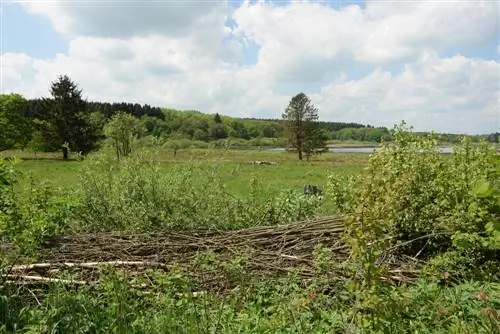
A Benje hedge is also a good choice for a horse pasture
If horses had a say in the construction of a paddock, they would enthusiastically advocate for a deadwood hedge. The clever horses don't care about the ecological value of dead wood. From the perspective of hungry horse eyes, the paddock is fenced in by an inviting branch bar that invites you to enjoy a nibble. For this reason, a Benje hedge within reach of horses' mouths may only be equipped with compatible, non-toxic clippings. These include, for example, the branches of fruit trees and berry bushes. However, the following are taboo: maple (Acer), barberry (Berberis), broom (Cytisus scoparius), boxwood (Buxus), yew (Taxus baccata), laburnum (Laburnum anagyroides) and especially the deadly poisonous ivy (Hedera helix).
Deadwood hedge - care tips
The deadwood hedge is an easy-care and useful component in natural garden design. Light maintenance work only becomes necessary over time. The following tips show the way to a perfectly maintained Benje hedge:
- Filling: regularly top up with fresh wood cuttings to compensate for decomposed cuttings
- Pruning: radically shorten or clear vigorous shrubs within the deadwood hedge
- Intermediate layers: sporadically insert thin layers of soil, leaves or perennial cuttings between the clippings
- Watering: water occasionally during summer droughts
Widespread weeds cannot miss the paradisiacal conditions of a deadwood hedge. For this reason, annoying weeding is also part of the care program.
Frequently asked questions
Which animals does the deadwood hedge in the garden serve as a habitat?
There's a lot of activity in an established deadwood hedge. Wild bees, beetles, spiders and earthworms have already arrived in the second year. The filling begins to decompose, producing valuable humus as a basis for life for many plants. Now it won't be long until hedgehogs, frogs, toads, dormouse and birds discover the deadwood hedge as a place to retreat.
Where can you create a deadwood hedge in the garden?
You can create a deadwood hedge in almost any location in the garden. A sunny to semi-shady location is highly recommended, which is very comfortable for many plants and animals. A place in the shade is possible, but there is a risk that only a few plants will settle through seeds. Furthermore, avoid damp, waterlogged garden soil because the natural decomposition process can be impaired by the formation of rot and mold.
Can clippings from any type of tree be allowed into the deadwood hedge?
Caution is advised with all trees that sprout again even after a radical pruning. These include, for example, blackberry rods. Cuttings from strong-growing trees and shrubs, such as birch, ash or sycamore, are also questionable. Due to its invasive nature, the clippings sprout within the Benje hedge. The growth rockets quickly overgrow the deadwood hedge and rob other plants of access to light.
How can you visually improve the appearance of a deadwood hedge?
At first, splashes of color in a deadwood hedge are in short supply. By placing colorful flower pots (€15.00 on Amazon) upside down on the posts, color comes into play. If you fill the pots with wood shavings beforehand, insects will be happy to have an inviting place to retreat. A small hedgehog house that you integrate into the deadwood hedge when setting up is decorative and useful. Place rustic plant containers next to your Benje hedge, lushly planted with wildflowers, the seeds of which will later contribute to the greenery.
Tip
In the self-cultivated cottage garden, the deadwood hedge acts as a perfect privacy screen for the compost heap. Boring, disease-prone box trees have long since become obsolete as bed borders. Instead, a decorative Benje hedge in mini format gives the vegetable beds authentic flair.

